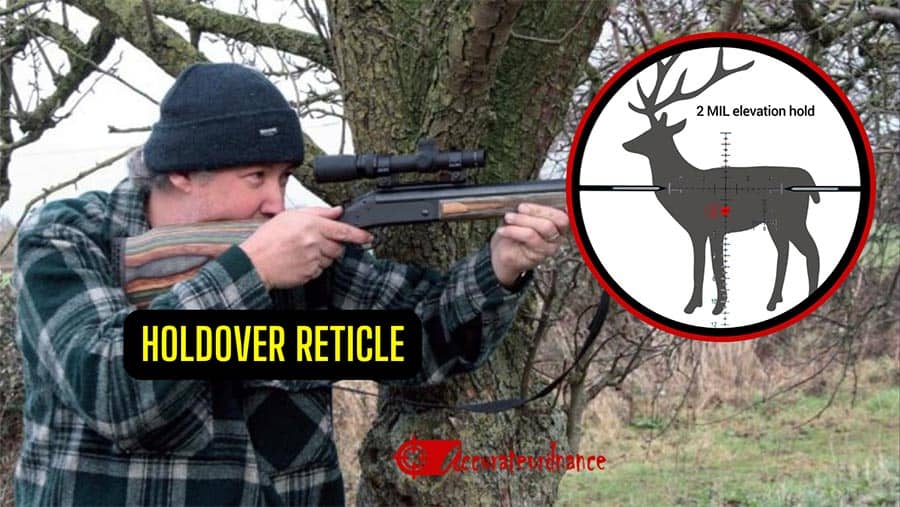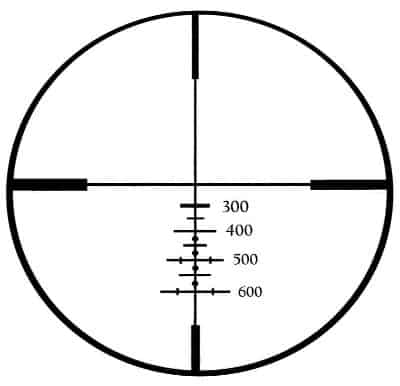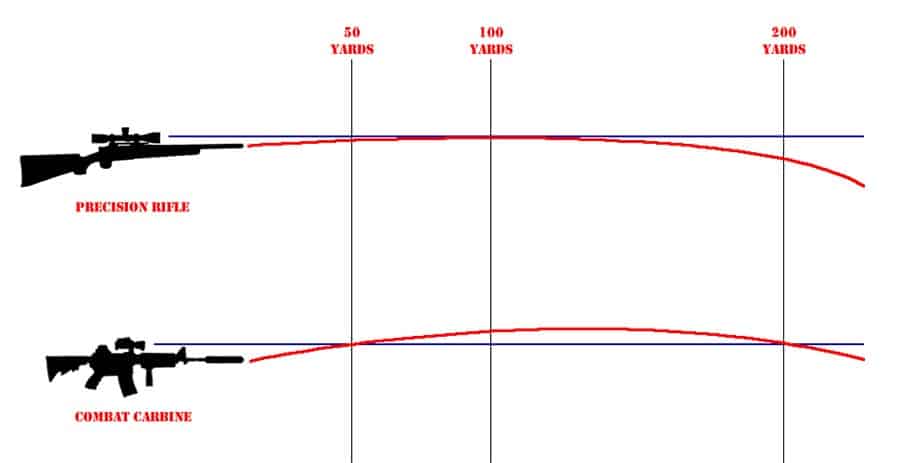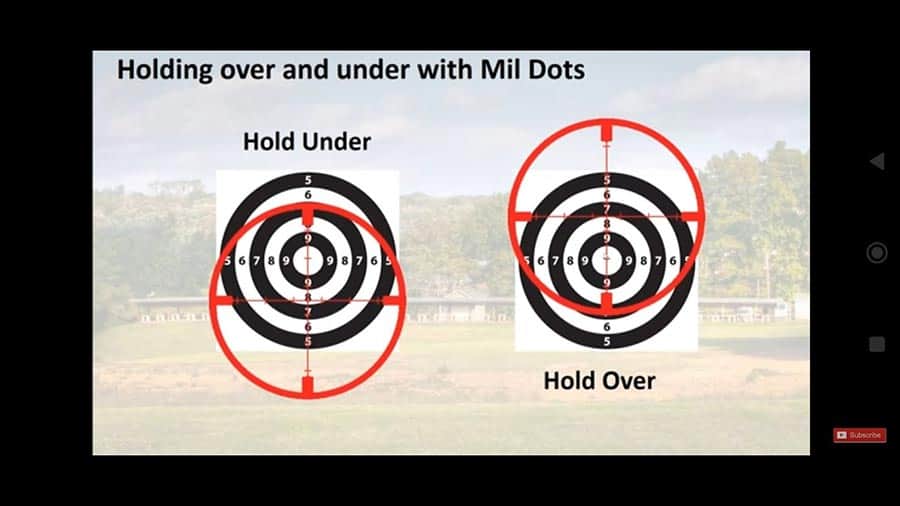If you’re a seasoned marksman or a beginner who understands the basics of shooting, using a riflescope with a holdover reticle can be a game-changer for you. A holdover reticle can help you ensure that your shots hit the mark. In this article, we’ll explain how to use a rifle scope with a holdover reticle and other things you need to know about holdovers.

- What is a holdover, and when do you need it?
- What is a holdover reticle?
- What Does ‘No Holdover’ at 300 Yards Mean?
- What is Holdunder?
- Types of Holdover Reticles
- Benefits of using holdover reticles
- Understanding bullet drop and how it affects your shot
- Ways to determine bullet drop
- Steps to adjusting for holdovers
What is a holdover, and when do you need it?
Holdover is a technique used in shooting to compensate for the effect of gravity on a bullet’s trajectory, and it refers to the amount by which a shooter must aim his crosshair above a target at a given distance to ensure a hit. Holdover is necessary when shooting at longer distances, typically beyond the range at which the shooter’s rifle is zeroed. As the distance to the target increases, the effect of gravity on the bullet becomes more pronounced, and the bullet’s trajectory will begin to curve downward. If a shooter aims directly at the target, the bullet will hit below the aiming point due to gravity’s effect, resulting in a miss.
To compensate for this, the shooter must aim above the target, using the holdover technique. Holdover can be achieved using a variety of methods, including using a holdover reticle, adjusting the elevation on the rifle scope, or using external ballistics calculators or range finders to determine the appropriate holdover for a given distance.
What is a holdover reticle?
A holdover reticle is a type of reticle used in riflescopes that helps shooters compensate for bullet drops at longer ranges. It is also known as a ballistic reticle or a BDC (Bullet Drop Compensator) reticle.
A holdover reticle typically consists of a series of dots, hash marks, or other markings that correspond to specific distances. The shooter can use these markings to aim higher than the target to compensate for the bullet’s drop due to gravity. By using a holdover reticle, the shooter can make quick and accurate adjustments to their aim without having to adjust the scope’s elevation or windage turrets.

Holdover reticles can also include markings that help compensate for wind drift. These markings indicate the amount of windage that needs to be accounted for when aiming, allowing the shooter to make quick and accurate shots instead of windage turret adjustments.
Holdover reticles come in different types, each with its own unique features and advantages. Some examples of holdover reticles include the BDC reticle and the Mil-dot reticle.
What Does ‘No Holdover’ at 300 Yards Mean?
If someone says that there is “no holdover” at 300 yards, they are likely referring to a specific shooting scenario where the bullet drop is minimal enough that the shooter does not need to adjust their aim or use any holdover compensation to hit the target accurately.
However, it’s important to note that whether or not a holdover is required at a given distance depends on several factors, including the caliber and weight of the bullet, the velocity of the round, the height of the shooter’s scope above the bore of the rifle, and the zero distance of the rifle.
For example, a shooter using a powerful rifle cartridge with a high velocity and a flat trajectory may be able to hit a target accurately at 300 yards without any holdover compensation. However, a shooter using a smaller caliber rifle cartridge with a slower velocity and a more pronounced bullet drop will likely need to use some form of holdover compensation to hit the same target at 300 yards.
In the diagram below, the combat carbine was zeroed at 50 yards, and it had a second zero at 200 yards. In this case, we can say that the rifle and scope setup has a “No Holdover at 200 yards” because you can use the same zero. Meanwhile, the precision rifle that was zeroed to 100 yards would need some holdover for it to accurately hit the target at 200 yards.

Note: As earlier mentioned, there’s no rule that says your particular rifle and scope setup will have a “No Holdover” at 300 yards. The “No Holdover” distance may vary depending on the factors we stated above in this section.
What is Holdunder?
Holdunder is a technique used in shooting to compensate for the effect of gravity on a bullet’s trajectory, much like holdover. However, while holdover involves aiming above the target to compensate for the bullet’s downward trajectory caused by gravity, holdunder involves aiming below the target to compensate for a bullet’s upward trajectory.
Holdunder is typically used in scenarios where the target is located at a higher elevation than the shooter, causing the bullet’s trajectory to rise above the point of aim before falling back down to hit the target. This often occurs when shooting at targets located on hillsides, mountainsides, or other elevated areas.

To compensate for the upward trajectory of the bullet, the shooter must aim below the target, using the holdunder technique. The amount of holdunder required depends on several factors, including the distance to the target, the caliber and weight of the bullet, the velocity of the round, and the angle of inclination between the shooter and the target.
Like holdover, holdunder can be achieved using a variety of methods, including using a holdunder reticle, adjusting the elevation on the rifle scope, or using external ballistics calculators or range finders to determine the appropriate holdunder for a given distance and angle of inclination.
Types of Holdover Reticles
Holdover reticles come in different types, each with its own unique features and advantages. Here are some of the most common types of holdover reticles:
BDC (Bullet Drop Compensator) Reticle
The BDC reticle uses a series of dots or hash marks that correspond to specific distances to help the shooter adjust their aim for bullet drop. The shooter can use the markings to aim higher than the target, compensating for the bullet’s drop due to gravity. BDC reticles are often designed for specific calibers and bullet weights, and they require the shooter to know the ballistics data of their ammunition to make an accurate scope adjustment.
Mil-dot Reticle
The Mil-dot reticle uses dots or marks to help the shooter calculate the range to the target and compensate for bullet drop. The shooter can use the dots to estimate the distance to the target and then use the corresponding markings to aim higher than the target, compensating for bullet drop. Mil-dot reticles are often used by military and law enforcement personnel, and they require the shooter to know how to calculate range and holdover.
Christmas Tree Reticle
The Christmas Tree reticle is a variation of the MOA reticle that uses a series of dots, hash marks, and lines to help the shooter compensate for bullet drop and wind drift. The reticle looks like a Christmas tree, with the dots and lines extending outward from the center. The shooter can use the markings to aim higher than the target and adjust for windage, making quick and accurate adjustments to their aim.
Duplex Reticle
The Duplex reticle is a simple reticle that uses a thin crosshair and thicker lines at the outer edges. The thicker lines can be used to help the shooter compensate for bullet drop, but the reticle is not as precise as some of the other holdover reticles. Duplex reticles are often used by hunters and shooters who need a simple, easy-to-use reticle.
Benefits of using holdover reticles
Using a holdover reticle in a riflescope has several benefits for shooters, including:
Quick Aiming
One of the main benefits of using a holdover reticle is that it provides shooters with quick and accurate aiming points. In contrast to traditional crosshair reticles, which require the shooter to adjust the scope’s elevation and windage turrets to compensate for bullet drop and wind drift. Holdover reticles give shooters a pre-determined aiming point that allows them to make quick and accurate adjustments to their aim. This can be especially useful in fast-paced shooting situations, such as hunting or tactical shooting, where quick shots and accurate targeting are essential.
Compensation for Bullet Drop
Holdover reticles provide shooters with a way to compensate for the bullet’s drop due to gravity. By using the markings on the reticle to aim higher than the target, shooters can ensure that the bullet hits its intended target, even at longer ranges where bullet drop is more significant. This is particularly important for long range shooting, where bullet drop can have a significant impact on accuracy.
Compensation for Wind Drift
In addition to compensating for bullet drop, some holdover reticles include markings that help shooters compensate for wind drift. Wind drift occurs when wind causes the bullet to drift off course, making it essential for shooters to adjust their aim to compensate for this effect. By using a holdover reticle with windage marks, shooters can quickly and accurately adjust their aim to compensate for wind drift, resulting in more accurate shots.
Increased Accuracy
Another significant benefit of using a holdover reticle is that it can increase a shooter’s accuracy. By compensating for bullet drop and wind drift, holdover reticles allow shooters to make more accurate shots at longer ranges, resulting in more successful hits and fewer missed shots. This can be particularly important for hunters who need to make quick and accurate shots on game animals or for competitive shooters who need to hit targets at an extended range and under different conditions.
Reduced Time and Effort
Holdover reticles can save shooters time and effort by eliminating the need to make manual adjustments to the scope’s elevation and windage turrets. Instead of adjusting the scope’s turrets, shooters can use the markings on the reticle to compensate for bullet drop and wind drift, making quick adjustments to their aim. This can be particularly useful when shooting in rapidly changing conditions, such as wind or weather, or when time is of the essence, such as in tactical shooting scenarios.
Versatility
Holdover reticles can be used with a variety of firearms and ammunition types, making them versatile tools for shooters and hunters. Whether using a rifle or a shotgun and regardless of the caliber or ammunition type, shooters can use holdover reticles to compensate for bullet drop and wind drift, allowing them to make accurate shots at longer ranges. This versatility makes holdover reticles an essential tool for hunters and shooters who use different firearms and ammunition.
Understanding bullet drop and how it affects your shot
We’re discussing bullet drop in this article because it is the main reason we need a holdover reticle. If bullets had a straight line or flat shooting at all times, then we would not need a holdover reticle.
Bullet drop is a natural phenomenon that affects the trajectory of bullets as they travel through the air toward a target. It is caused by the force of gravity acting on the bullet and slowing it down, causing it to drop toward the ground. The amount of bullet drop that occurs depends on several factors, including the bullet’s weight, shape, velocity, and the distance it travels. For example, a heavier bullet will experience more bullet drop than a lighter bullet, while a bullet traveling at a higher velocity will experience less bullet drop than a bullet traveling at a lower velocity.
Bullet drop becomes more significant at a long distance, as the bullet has more time to be affected by the force of gravity and air resistance. As a result, shooters must understand how bullet drop affects their shots to make an accurate long distance shot.
One way to compensate for bullet drop is by using a holdover reticle. Holdover reticles are reticles that have pre-determined aiming points that allow shooters to aim higher than their target, compensating for the bullet’s drop. For example, a holdover reticle may have markings that indicate where to aim for a 100 yards shot, 200 yards shot, and so on.
Another way to compensate for bullet drop is by adjusting the elevation turret on your scope. The elevation turret allows you to adjust the point of impact of your shot by changing the angle of the scope’s crosshairs. By adjusting the elevation turret, you can raise the point of impact of your shot, compensating for the bullet’s drop.
To effectively compensate for bullet drop, you need to know the distance to your target, the weight of your bullet, and the muzzle velocity of your firearm. With this information, you can calculate the amount of bullet drop that will occur and use a holdover reticle or adjust your scope’s elevation turret to compensate for it.
Ways to determine bullet drop
To accurately compensate for bullet drop, shooters need to determine the amount of drop that will occur at a given distance. There are several tools and techniques that shooters can use to determine bullet drop, including ballistic calculators, range finders, and bullet drop compensator (BDC) charts.
Ballistic calculators
Ballistic calculators are computer programs or mobile apps that use data such as bullet weight, velocity, and ballistic coefficient to calculate the amount of bullet drop that will occur at a given distance. Shooters can enter their firearm and ammunition data into the calculator and receive a detailed ballistic solution that accounts for bullet drop, wind drift, and other factors that can affect their shot.
Range finders
Range finders are devices that measure the distance to a target. By accurately determining the distance to their target, shooters can use BDC charts or holdover reticles to compensate for bullet drop. Range finders are available in various types, including a laser rangefinder, a GPS rangefinder, and an optical rangefinder.
Bullet drop compensator (BDC) charts
Bullet drop compensator (BDC) charts are tables that provide shooters with pre-calculated holdover or elevation adjustments for specific loads and distances. These charts are typically provided by the manufacturer of the rifle scope and are specific to the reticle of the scope. Shooters can use BDC charts to determine the amount of holdover or elevation adjustment required to compensate for bullet drop at different distances.
Steps to adjusting for holdovers
Adjusting for holdovers involves a few key steps to ensure that you can accurately hit targets at various ranges. Here are the steps you can follow to adjust for holdovers:
Determine the distance to your target
Use a rangefinder or other method to determine the distance to your target. This is important because it will help you select the appropriate holdover point for your reticle.
Understand your reticle
Familiarize yourself with your scope’s reticle and its holdover markings. Some reticles have specific holdover points for specific distances, while others may require you to estimate the holdover based on the distance to your target.
Calculate your bullet drop
Use a ballistic calculator or other methods to determine the amount of bullet drops you can expect at your target’s distance. This will help you determine the appropriate holdover point on your reticle.
Make adjustments
Based on your calculations, make the necessary scope adjustment to account for the bullet drop at your target’s distance.
Practice
Practice using your scope at various distances and with different holdover points to become familiar with its capabilities and limitations. This will help you become more confident and accurate when shooting at an extended range.

Mike Hardesty is a published freelance gun writer. He also possesses specialized expertise in rifle scopes With dozens of articles and reviews published in Pew Pew Tactical, Snipercountry.com, and TTAG (The Truth About Guns), Mike is considered a firearms expert. His special area of expertise is handguns.
Mike is a long-time shooter. He has been punching paper targets, taking deer and other game and shooting at competitions since about 1975. Other related pursuits include reloading and bullet casting. He currently reloads for over 10 calibers, both handgun and rifle. His reloads, particularly for 9mm, were in great demand during the height of the ammo shortage among family and friends. He donated hundreds of rounds to informal shooting sessions. He was quoted as saying “I do not sell my reloads but I sure will help my guys shoot ’em for free!”. He has a few cherished firearms that he has inherited or otherwise procured — those are his favorites.
He earned B.S. and M.S. degrees from Indiana State University in 1974-1975.
He’s a firearm experts and is the founder of mhardesty.com.
